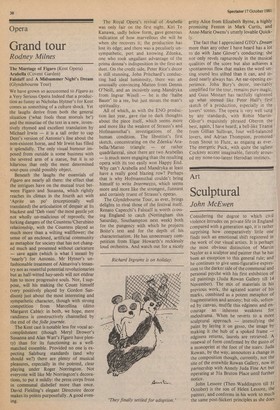Art
Sculptural
John McEwen
Considering the degree to which civil violence intrudes on private life in England compared with a generation ago, it is rather surprising how comparatively little one finds such an emotional shift registered in the work of our visual artists. It is perhaps the most obvious distinction of Martin Naylor as a sculptor and painter that he has been an exception to this general rule; and he continues to give semi-figurative expression to the darker side of the communal and personal psyche with his first exhibition of oil paintings (Juda Rowan Gallery till 14 November). The mix of materials in his previous work, the agitated scatter of his marks, combined as a potent metaphor of fragmentation and anxiety; but oils, softened by canvas, muffle this edginess and encourage an inherent weakness for melodrama. When he reverts to a more sculptural approach — intensifying the paint by laying it on gesso, the image by making it the hub of a spoked frame — edginess returns, laurels are retrieved. A renewal of form confirmed by the gusto of a monoprint at the foot of the stairs. Juda Rowan, by the way, announces a change in the composition though, currently, not the site of the erstwhile Rowan Gallery, now in partnership with Annely Juda Fine Art but operating at 31a Bruton Place until further notice.
John Lessore (Theo Waddington till 31 October) is the son of Helen Lessore, the painter, and conforms in his work to much the same post-Sickert principles as she does in hers: everyday subjects, tones rather than colours, expressive surfaces. This last, the degree to which he concerns himself with surface effects and paint as stuff, is what most distinguishes his style. He can paint neatly and wet on wet in a Frenchified way or build it up stodgily and dry in the earthbound tradition of mid-Europe. There are admirable examples of both on display, but he is at his best — and it makes him worthy of inclusion in any survey of current figurative painting — when the two are -combined, as in the small, grey, finely observed 'Making Curtains' — quite rightly chosen to illustrate the cover of the catalogue.
Peter Kinley (Knoedler Gallery till 31 October) was born in Vienna but he does not use paint like dubbin; on the contrary, he is a French vinaigrettist. Generalised silhouettes of houses, hills, birds and cows are placed, one or two to a picture, in fields of thin and muted monochrome colour. The content is too insubstantial to carry a large canvas, too close to Play School when small and dissolves into whimsy the second a duck is given an eye or a cow a patch. On a modest rather than a humble scale and in as sternly an abstract form as possible they have a place, at least in an ideal 'Habitat' home.
Bryan Kneale (Redfern Gallery till 23 October) is a Manxman, and a Celtic predilection for roots, tangles and organic complications characterises his latest sculptures — as it did those in his previous show. Many are in oxidized bronze and can hang on the wall. They look a bit like enlarged Pieces of abstract jewellery. The Celtic strain in Kneale vulgarises his art. Sensual relish is too loudly proclaimed, his skill as a craftsman over-stated. The more restrained and geometric his work, the more correct the balance. There are one or two objects here that hint at the delicate excellence of his first show at the Taranman Gallery, but not enough.
Surrealism was too rude and unruly to catch on in England, but a wild fetishistic head by Eileen Agar in the current survey of Pre-1950 British sculpture at the Whitechapel shows that in the Thirties she at least partook of the spirit of the move ment. Little of this necessary fierceness is visible in her latest show of gaily coloured acrylic paintings at the New Art Centre (til 27 October). Ideas have here been chewed into the cud of design. These neat and partial figurative juxtapositions speak of the selfrather than the sub-conscious. The pilot-light of imaginative enterprise burns 9n only in some of the small works — 'Flying Tiger', 'The Fish', 'Fancy Tree'. Virginia Powell (Maclean Gallery till 28 October) works within more modest, il lustrative boundaries. She describes the things she likes: cottage flowers (Predominantly), holidays abroad, quiet Corners of her house. For all their charm they are commendably unsentimental; strongest in design when an observed pattern is incorporated, and best conveyed in Pastel.







































 Previous page
Previous page